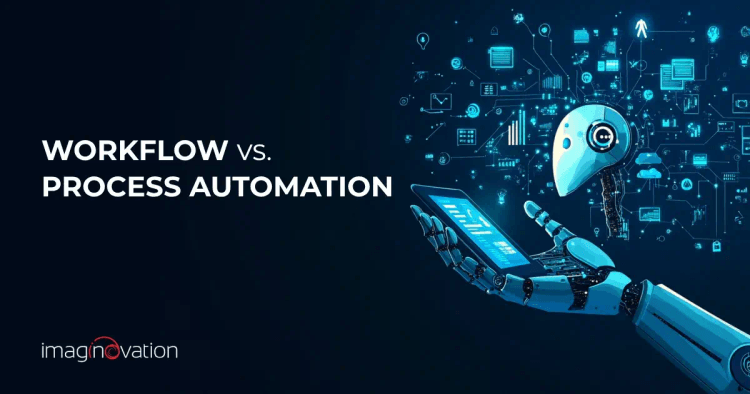In today’s business world, countless tasks—such as payroll and order processing—can easily become repetitive and error-prone. Therefore companies are turning to automation to streamline operations and minimize errors to stay competitive.
A recent study found that 31% of businesses have fully automated at least one core function, while another shows that 51% of automation efforts are aimed at boosting overall efficiency.
If you’re a business leader looking to harness the power of automation, understanding the difference between Workflow and Process Automation is key.
Please keep reading to learn the nuances of "Workflow" and "Process Automation", explore their benefits, and outline the steps to seamlessly integrate automation into your business operations.
Let’s dive in!
Defining Workflow Automation and Process Automation
Automation is one of today's hottest buzzwords, sparking trends like workflow automation and process automation. While they may sound similar, each plays a unique role in boosting efficiency.
Let’s dive into the basics and explore what sets them apart.
What is Workflow Automation?

Workflow Automation adopts technology to automate and streamline business processes by managing tasks, data, and interactions in a structured manner. It involves creating a sequence of steps, or tasks, that define how work is completed, enabling organizations to reduce manual effort, minimize errors, and improve efficiency.
Let’s look at some common examples of workflow automation in action:
- Automatic Calendar Scheduling: Set up meetings and events without lifting a finger, as tasks automatically generate calendar invites.
- Real-Time Email Alerts: Receive instant notifications whenever a task's status changes, so you're always in the loop.
- Instant Service Requests: Convert email inquiries or form submissions into actionable service tickets effortlessly.
- Deadline Reminders: Get timely alerts when work is approaching its due date, helping teams stay on track.
Workflow automation frees up your time, reduces errors, and keeps everything running smoothly, so you can focus on the bigger picture. Next, let’s look at process automation.
What is Process Automation?

Process Automation specifically adopts technology to automate entire business processes and workflows. When it comes to its focus, it is on the integration of various systems and applications to enhance efficiency and accuracy.
Unlike Workflow Automation, which primarily automates individual tasks or sequences of tasks within a specific workflow, process automation encompasses a broader scope. It automates end-to-end processes that may involve multiple departments, systems, and complex interactions.
Let’s dive into some exciting examples of process automation that are reshaping how businesses operate:
- Customer Support: Imagine having chatbots ready 24/7 to tackle everyday customer inquiries. These virtual assistants can provide instant answers, boosting customer satisfaction and reducing response times.
- Marketing Automation: Harness the power of AI algorithms to dive deep into customer data. By analyzing preferences and behaviors, you can craft personalized campaigns that truly resonate, driving engagement and skyrocketing sales.
- Supply Chain Management: Automating procurement processes—like order placement and invoice management—streamlining operations, minimizing errors, and increasing efficiency is easy.
By adopting process automation, businesses can achieve greater efficiency, reduce operational costs, and allow employees to focus on strategic, value-adding activities.
Key Differences Between Workflow and Process Automation
In short, workflow automation focuses on automating specific tasks or activities within a process, while process automation takes a more comprehensive approach, streamlining entire end-to-end business processes.
But when it comes to choosing the right solution for your business, understanding their key differences is crucial to making an informed decision.
Let’s break it down further to help you determine which one aligns best with your needs.
1. Primary Focus
Workflow automation focuses on optimizing specific tasks or activities within a single workflow or department. It’s designed to automate smaller, repetitive actions, making processes within that area faster and more efficient.
In contrast, process automation takes a more expansive approach, targeting entire end-to-end processes that span across multiple departments. It’s about transforming and streamlining large-scale operations for greater overall efficiency.
2. Complexity
Workflow automation is your go-to for managing simpler, smaller tasks at a granular level. It’s perfect when you need to streamline routine actions without diving into complex systems.
On the flip side, if you’re dealing with intricate business processes that require a big-picture approach, deeper data analysis, and strategic execution, process automation is the way to go. With the help of advanced technologies like Artificial Intelligence (AI), Robotic Process Automation (RPA), and Business Process Management (BPM) software, process automation can handle this complexity with ease, delivering seamless, intelligent automation across your business.
3. Integration Potential
When it comes to workflow automation, integration options are somewhat limited. The focus tends to be on managing tasks and information flow within specific teams or departments.
In contrast, process automation, especially when paired with an integration platform as a service (iPaaS), opens up a world of possibilities. It can seamlessly connect various applications, systems, and data sources, enabling full end-to-end automation across an organization. This vast integration potential makes process automation a powerful tool for driving efficiency and scalability.
4. Flexibility and Scalability
Workflow automation provides great flexibility, particularly for automating specific, targeted tasks. It also empowers teams by minimizing their dependence on the IT department.
In contrast, process automation demands more in-depth planning and resources, but it truly excels when managing complex business processes across multiple departments. Its ability to scale and adapt makes process automation a robust solution for businesses aiming to streamline and grow efficiently.
Table 1: Key Differences between Workflow Automation and Process Automation in a Snapshot
| Key Differences | Workflow Automation | Process Automation |
| Scope and Complexity | Focuses on automating individual tasks or specific workflows and can handle linear, routine tasks efficiently | Involves automating entire business processes and addresses more complex, end-to-end operations |
| Integration Capabilities | Has limited integration and relies on pre-set templates or basic rules that don't require much cross-platform communication | Provides extensive integration potential, especially when combined with platforms like iPaaS (Integration Platform as a Service) |
| Customization | Typically operates based on predefined templates and rules, limiting the extent of customization | Offers deeper customization, allowing businesses to tailor automation processes based on their unique requirements |
| Flexibility and Scalability | While flexible for targeted, specific tasks, it can be restrictive when it comes to scaling across larger, more complex operations | Highly scalable and flexible |
| Resource Requirements | Requires fewer resources and less time to implement, as it focuses on small-scale tasks | Demands more time, resources, and planning, as it involves automating broader, more intricate business processes |
Benefits of Implementing Workflow and Process Automation
Understanding the key differences between automation types unlocks a clear path to finding the perfect fit for your business. Now, let's dive into the exciting benefits each type of automation offers and see how they can elevate your operations.
Benefits of Workflow Automation
Imagine there is a marketing team that is working on a product launch. Using a workflow management tool, the team leader can assign tasks for content creation, graphic design, and social media promotion to different team members. Each member will benefit from having a view of the overall project timeline and where their task fits in.
Thus, workflow management can significantly enhance collaboration and connectivity by streamlining processes and fostering communication across teams. It streamlines task assignments and integrates seamlessly with other tools, allowing teams to stay connected and informed.
One of the standout advantages of workflow automation is the boost in transparency it provides. By clearly outlining each step and process, everyone gains a deeper understanding of how things flow internally. It also clarifies who owns which tasks and what the next steps are. This clarity fosters trust among employees, empowering them to take greater ownership and become more engaged in their roles.
Workflow automation streamlines tedious manual tasks and manages the repetitive work that often clogs up business processes. With routine tasks taken care of, employees can concentrate on more important, high-value projects that truly drive the business forward.
Cost savings are one of the biggest reasons companies turn to workflow automation, but the benefits don’t stop there. By slashing the time and resources spent on manual tasks, businesses can dramatically reduce their operational costs. Automation tools cut down on paperwork, shrink administrative overhead, and eliminate costly human errors.
Relieving employees of repetitive tasks can dramatically increase job satisfaction and reduce turnover. When the daily grind of mundane work is minimized, employees can shift their focus to more engaging, impactful projects, which leads to higher morale and greater fulfillment. This newfound engagement not only promotes personal growth but also fosters a more positive workplace environment. As a result, companies benefit from lower turnover rates and the reduced costs of constantly recruiting and training new talent. By empowering employees with more meaningful work, businesses create a happier, more loyal workforce.
Benefits of Process Automation
Process automation is no longer just an option—it’s a strategic necessity for boosting productivity. Wondering how? Let's break it down: automation minimizes human errors, improves product quality, and allows employees to focus on high-value tasks. By harnessing advanced technology, businesses can enhance overall efficiency and elevate customer satisfaction.
When it comes to completing tasks, it's common for different employees to approach the same process in varied, and often less efficient, ways. Process automation solutions eliminate this inconsistency by ensuring that tasks are completed according to the rules and guidelines you set. This leads to standardized workflows, consistent results, and greater transparency across the organization. With automation in place, your team can work more efficiently, delivering reliable outcomes every time.
For instance, in an automotive plant, automated systems can inspect each part for defects like size discrepancies or surface imperfections, following a uniform process every time. This ensures consistent product quality, reduces human error, and standardizes the entire inspection process, leading to higher reliability and efficiency.
Regulatory compliance is often complex and requires cross-functional collaboration. Traditionally, compliance frameworks have depended on manual processes like spreadsheets, paperwork, in-person meetings, and training sessions. These systems rely heavily on human oversight, making them inefficient, error-prone, and difficult to scale. Additionally, they often lack consistency, struggle to adapt to new regulations, and can't efficiently analyze large volumes of data.
With process automation, these challenges can be easily addressed. Automation streamlines compliance processes, making it easier to meet regulatory requirements. It also enhances trackability, provides real-time visibility, simplifies reporting, and improves data security. In turn, organizations can respond more quickly to new compliance demands while reducing errors and increasing operational efficiency.
Process automation plays a key role in driving growth and scalability for organizations. Typically, in a manual setup, service delivery is often limited by resources like time and staff, making it difficult to keep up with growing demand. Process automation enables businesses to handle multiple tasks simultaneously, increasing both the quantity and quality of work done in a given timeframe.
Evaluating Your Business Needs for Automation
With all the benefits automation offers, the big question is: which type of automation is right for your business? Here are a few key aspects that could steer your decision.

Opt for Workflow Automation
If you're looking to automate specific tasks rather than entire end-to-end processes, workflow automation is your best bet. It's perfect for handling short, straightforward tasks and is an ideal solution when you're not focused on managing complex, multi-step operations.
For example, if you need to streamline approvals, notifications, or data entry, workflow automation ensures that these tasks run smoothly, saving time and boosting efficiency without overcomplicating things. It's the go-to solution for optimizing individual tasks while keeping things simple and effective.
Opt for Process Automation
On the other hand, process automation is perfect for organizations looking to streamline entire workflows or projects from start to finish. It's especially effective for managing complex, interdependent tasks.
If you're dealing with intricate, multi-step processes, process automation offers a holistic approach to optimize your operations. Whether it's coordinating multiple systems or automating a sequence of tasks, this type of automation ensures everything runs smoothly and efficiently, helping your business scale while minimizing manual effort.
Here are some key factors to consider when deciding between workflow automation and process automation for your business:
1. Business Size
Workflow automation shines when handling smaller tasks within larger processes, making it ideal for small to mid-sized businesses looking to streamline day-to-day operations. However, if you are looking at automating complex business processes that span multiple departments or even the entire organization, you would prefer to choose process automation. That said, workflow automation isn’t limited to small businesses—larger companies can also use it for more intricate tasks like project or inventory management, providing efficiency without overhauling everything.
2. Industry Focus
Workflow automation tends to be more common in industries like human resources, accounting, and customer support, where repetitive tasks need standardization and optimization. It’s perfect for handling routine processes such as onboarding, invoice approval, or customer ticketing. On the other hand, process automation is better suited for industries that require complex, data-driven workflows—think of areas like supply chain management, finance, or logistics. It automates broader business processes that demand analysis, strategic insights, and seamless integration across multiple systems.
3. Existing IT Infrastructure
If you already have an existing IT infrastructure, the way you integrate automation is key. Workflow automation works seamlessly as a plug-in or add-on to your current systems (like CRM, email, or task management tools). It automates specific tasks, enhancing efficiency without requiring a complete overhaul. Process automation, however, is more comprehensive. It links various systems, allowing data and tasks to flow effortlessly across teams and departments. For organizations with complex needs, process automation can enhance or even replace legacy systems, providing a more integrated and holistic approach.
4. Security and Compliance
Yet another facet that can influence your choice is the scope of security and compliance management. If you need to automate individual tasks—such as approvals, audit trails, or compliance notifications—workflow automation can deliver great results. But if you’re managing full-scale compliance programs or security protocols that span multiple departments and systems, process automation offers a more robust solution. It can handle comprehensive compliance management with real-time monitoring and coordination across your organization’s infrastructure.
5. Cost and ROI
Maximizing ROI often involves finding the right balance between both types of automation. While workflow automation is often more affordable and quicker to implement, process automation can provide greater long-term value by optimizing end-to-end business operations. For many organizations, combining both approaches might be the most cost-effective strategy—using workflow automation for simpler tasks and process automation for more complex, large-scale workflows.
Implementing Automation in Your Business Operations
1. Set Clear Objectives
Define specific, measurable, and time-sensitive goals that align directly with your overall business strategy. These targets will act as your roadmap and help you gauge success along the way.
2. Spot Repetitive Tasks
Dive deep into your operations to pinpoint areas where tasks are being repeated over and over. These are often the easiest and most impactful areas to introduce automation.
3. Visualize Your Current Processes
Lay out your existing workflows step by step. By mapping them, you'll gain a clearer picture of how tasks flow through your organization and where improvements can be made.
4. Identify Bottlenecks
Analyze your processes to find inefficiencies. Where do things slow down? Where are errors most likely to occur? These pain points will offer you insights that can help you with areas of automation.
5. Choose the Right Automation Tools
Look for automation software that meets your needs. Key features to consider include intuitive drag-and-drop workflow builders, robust task management capabilities, and seamless integration with other software your business already uses.
6. Automate Strategic Tasks
Once you’ve selected the right tools, identify and prioritize which tasks to automate first—things like email management, invoicing, and repetitive data entry are great starting points.
7. Review and Refine Workflows
Automations run consistently, following the same steps each time. Regularly assess how well these workflows are performing to ensure they're driving efficiency and meeting your business goals.
8. Ensure IT Infrastructure Readiness
Before implementing automation on a wide scale, ensure your IT infrastructure is equipped to support it. It is prudent to check if you have sufficient tech support to keep your automation tools running smoothly and securely.
By following these steps, you can create a more efficient, streamlined operation that frees up time and resources for higher-value work.
Wrapping Up
Automation isn’t just a trend—it's becoming a business imperative, with an estimated 80% of organizations set to embrace intelligent automation by 2025. For C-level executives, now is the time to fully integrate automation strategies and future-proof your enterprise. Both Workflow Automation and Process Automation offer powerful paths to operational excellence, but each has its strengths.
The challenge lies in determining which approach best suits your organization’s unique needs—or perhaps blending both to unlock a new level of efficiency and drive unparalleled growth. Embrace automation now to stay ahead of the curve.
Optimize Your Business Operations with Imaginovation
Ready to optimize your business operations and thrive in the digital age? Partner with Imaginovation, an award-winning web and mobile app development company in Raleigh, to build cutting-edge automation solutions.
Our extensive experience in cutting-edge technologies and automation—encompassing both workflow and process automation—enables us to help you optimize your processes, driving significant improvements in efficiency, growth, and ROI.
Let us bring your vision to life by implementing automation strategies that set your business up for success.
Ready to build an app, but not sure where to start?
We've got you covered. Click the button below to get started.





